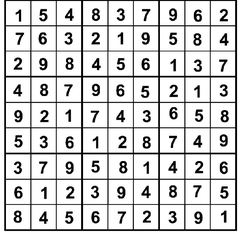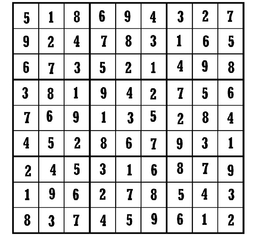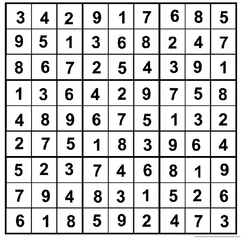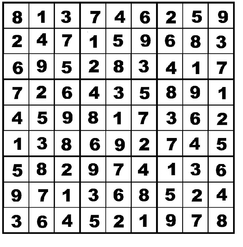Death by Sudoku (26 page)
Authors: Kaye Morgan

The Guessing Option (Ariadne’s Thread)
This weekend I leave the foggy shores of the Oregon coast for sunny La-la Land and a sudoku tournament. The first Southern California Invitational Sudoku Tournament takes place on Saturday at the Irvine Skytrails Hotel near scenic John Wayne Airport.
Ten Things Not to Do
at a Sudoku Tournament
I hope to see you at the next sudoku get-together, whether it’s local or international. Meantime, happy solving!





If you find yourself in a situation where no technique seems to work and you’re forced to guess your next move, you’re probably either trying to solve a faulty puzzle—or somewhere along the line you’ve created a faulty solution. The whole basis of sudoku is supposed to be logic, not luck. Still, if you have no other choice, you might consider an exercise in structured probability. That is, making a guess and keeping track of where it leads you.
Some sudoku theorists give this technique the high-flown name of Ariadne’s thread. (In Greek legend, Ariadne gave the hero Jason a ball of thread to help him find his way out of the labyrinth.)
Unlike forcing chains, where you’re looking for a particular result, or Nishio, where you’re expecting to fail, in this case you’re hoping to succeed. Each time you discover a dead end, you backtrack along the line of logic to your previous choice and take the alternate route.
Essentially, it’s a case of trial and error, and it’s the method most computers use to solve sudokus. In the world of paper puzzles, however, it can use up a lot of pencil lead—and erasers! You’ll certainly want to use an overlay to attempt this method. And, unless you’re the kind of person who can walk out on a rainy street and immediately hail a taxi, you may not want to depend so heavily on luck.
Look in the BackThe stricter members of Sudoku Nation may disapprove, but if you’re really stuck on a puzzle, why not peek in the back of the book or magazine at the offered solution? Many computer sudoku-solving programs offer a hint option. So why shouldn’t paper-and-pencil sudoku addicts take advantage of the same “technique”?
I hope you don’t often find yourself in such desperate straits. But remember, sudoku is supposed to be fun, not a source of stress.
Help put the “happy” in “Happy solving!”
Sudo-cues
A Look at What Not to Do at a
Sudoku Tournament
Sudoku Tournament
Written by Oregon’s own leading sudoku columnist, Liza K
This weekend I leave the foggy shores of the Oregon coast for sunny La-la Land and a sudoku tournament. The first Southern California Invitational Sudoku Tournament takes place on Saturday at the Irvine Skytrails Hotel near scenic John Wayne Airport.
The SCIST is the brainchild of puzzlemaker extraordinaire Will Singleton, who some years ago decided to graduate from crosswords to sudoku. His puzzles are syndicated all over the country, and if anyone can claim grand-master status in Sudoku Nation, it’s Will. He expects somewhere in the neighborhood of three hundred people to turn up in search of trophies and modest cash prizes. (Yes, modest—which is to be expected. Do the math, people. For a million-dollar prize, the entrance fee for three hundred people would have to be in the neighborhood of $300,000. I’m not willing to ante up to that neighborhood! Are you?)
Sudoku lovers from all over the West Coast will be going for the glory, if not for riches, including yours truly. If I come back with a trophy, you can expect to see a picture here.
Tournament sudoku is still in its infancy here in the USA. However, I’ve attended more than a few of these gatherings, both here and abroad, and noticed that some of the participants manage to ruin not only their own enjoyment of the competition, but everyone else’s, by making some basic bloopers. As a result, I’ve developed this list.
Ten Things Not to Do
at a Sudoku Tournament
1.
Don’t Don’t forget your brain.
Some tournaments take place over the course of a whole weekend, and some people are so glad to meet other members of Sudoku Nation that they hit happy hour too hard. Hangovers and sudoku don’t mix. One-day events like the SCIST have another brain-draining drawback—travel. To make my morning flight from the Portland airport, I figure I’ll have to be leaving around the same time the party-hearty types here in town will be coming home. I’m really hoping I don’t forget to pack my brain.
Don’t Don’t forget your brain.
Some tournaments take place over the course of a whole weekend, and some people are so glad to meet other members of Sudoku Nation that they hit happy hour too hard. Hangovers and sudoku don’t mix. One-day events like the SCIST have another brain-draining drawback—travel. To make my morning flight from the Portland airport, I figure I’ll have to be leaving around the same time the party-hearty types here in town will be coming home. I’m really hoping I don’t forget to pack my brain.
2.
No artificial enhancements.
In this nip/tuck world where everyone can get a smaller nose or bigger breasts, tournament sudoku requires contestants to attend as the good Lord made them, at least mentally (the nose and breasts are allowed, if not encouraged). That means you can’t come into the contest arena with items like handheld sudoku solvers, or anything that might be used as a sudoku solver, such as laptop computers, cell phones, or BlackBerries. Personal digital assistants need not apply. Tournament sudoku is a game for plain, unvarnished brains.
No artificial enhancements.
In this nip/tuck world where everyone can get a smaller nose or bigger breasts, tournament sudoku requires contestants to attend as the good Lord made them, at least mentally (the nose and breasts are allowed, if not encouraged). That means you can’t come into the contest arena with items like handheld sudoku solvers, or anything that might be used as a sudoku solver, such as laptop computers, cell phones, or BlackBerries. Personal digital assistants need not apply. Tournament sudoku is a game for plain, unvarnished brains.
3.
No peeking!
I once attended a fairly crowded sudoku tournament in Tokyo where the guy next to me kept dropping his pencil. I thought he was checking me out until I realized he alternated between me and the guy on his other side. No, he wasn’t an equal opportunity pervert, lusting after both of our bodies. He was interested in our brains—specifically, the brainpower we’d put into solving the puzzles in that round. It didn’t help. In the end, Peeping Tomasu got ejected for “causing a disturbance.” So don’t cheat. And if you’re going to cheat, don’t use a method that any grammar school teacher can spot.
No peeking!
I once attended a fairly crowded sudoku tournament in Tokyo where the guy next to me kept dropping his pencil. I thought he was checking me out until I realized he alternated between me and the guy on his other side. No, he wasn’t an equal opportunity pervert, lusting after both of our bodies. He was interested in our brains—specifically, the brainpower we’d put into solving the puzzles in that round. It didn’t help. In the end, Peeping Tomasu got ejected for “causing a disturbance.” So don’t cheat. And if you’re going to cheat, don’t use a method that any grammar school teacher can spot.
4.
Don’t forget your tools.
Besides banning artificial aids, most tournaments limit the other things you can bring. For instance, the SCIST entry rules specifically state that contestants can only sit down with two pencils and two pens each. A wise competitor not only comes prepared with what’s allowed, he/she also checks that those tools work. Pens should be full of ink, pencils should have good points
and
good erasers. Any halfway decent sudoku involves a lot of pencil work, listing possible candidates for each space. You want to turn in a clean solution to the puzzle. I’ve seen people lose tournaments because their solutions were ruled illegible.
Don’t forget your tools.
Besides banning artificial aids, most tournaments limit the other things you can bring. For instance, the SCIST entry rules specifically state that contestants can only sit down with two pencils and two pens each. A wise competitor not only comes prepared with what’s allowed, he/she also checks that those tools work. Pens should be full of ink, pencils should have good points
and
good erasers. Any halfway decent sudoku involves a lot of pencil work, listing possible candidates for each space. You want to turn in a clean solution to the puzzle. I’ve seen people lose tournaments because their solutions were ruled illegible.
5.
Don’t expect it to be easy.
Okay, you can do every puzzle in
The Complete Nincompoop’s Guide to Sudoku.
Does that mean you’re ready for tournament competition? Probably not. You won’t have enough techniques under your belt to deal with the kind of puzzles serious competitors can solve. The SCIST has five entry rounds. Only five people in each round will graduate to the final challenge. You can expect that people going for the gold (or the gold-tone plastic trophy) won’t be finding it easy. My advice? Wait till you can solve the difficult newspaper puzzles—the ones that appear in the Sunday editions—before you go taking your sudoku addiction public. (No, this is not an attempt to clear the field for myself at the SCIST!)
Don’t expect it to be easy.
Okay, you can do every puzzle in
The Complete Nincompoop’s Guide to Sudoku.
Does that mean you’re ready for tournament competition? Probably not. You won’t have enough techniques under your belt to deal with the kind of puzzles serious competitors can solve. The SCIST has five entry rounds. Only five people in each round will graduate to the final challenge. You can expect that people going for the gold (or the gold-tone plastic trophy) won’t be finding it easy. My advice? Wait till you can solve the difficult newspaper puzzles—the ones that appear in the Sunday editions—before you go taking your sudoku addiction public. (No, this is not an attempt to clear the field for myself at the SCIST!)
6.
Don’t dawdle.
Tournament sudoku is definitely not like the play-at-home version, where you can put the book, paper, or magazine down to answer the phone or get a snack. Contestants get only forty-five minutes to finish their puzzles. And only the five quickest solvers go on to the next round.
Don’t dawdle.
Tournament sudoku is definitely not like the play-at-home version, where you can put the book, paper, or magazine down to answer the phone or get a snack. Contestants get only forty-five minutes to finish their puzzles. And only the five quickest solvers go on to the next round.
7.
Don’t rush.
This may seem contradictory after the last warning. Yes, you want to be in the top five, so you’ve got to solve these suckers quickly. But you don’t want to move so quickly that you miss mistakes in your solution and disqualify yourself. Always budget time to check over your work.
Don’t rush.
This may seem contradictory after the last warning. Yes, you want to be in the top five, so you’ve got to solve these suckers quickly. But you don’t want to move so quickly that you miss mistakes in your solution and disqualify yourself. Always budget time to check over your work.
8.
Don’t forget the bathroom.
You may be a sudoku whiz, but you won’t do well solving a puzzle if you’re distracted by—forgive this dreadful pun—the urge to whiz. Tournament officials do not stop the clock in the middle of a competition for bathroom breaks. Do it on your own time, and if nerves send you to the bathroom frequently, take precautions in advance. That third cup of coffee before the competition round might just have unwelcome consequences!
Don’t forget the bathroom.
You may be a sudoku whiz, but you won’t do well solving a puzzle if you’re distracted by—forgive this dreadful pun—the urge to whiz. Tournament officials do not stop the clock in the middle of a competition for bathroom breaks. Do it on your own time, and if nerves send you to the bathroom frequently, take precautions in advance. That third cup of coffee before the competition round might just have unwelcome consequences!
9.
Don’t forget your cold or allergy pills.
When you’re racing the clock, you don’t want to take time out to blow your nose. The contestants around you won’t appreciate it, either, not to mention the distracting effect of disgusting snuffling noises or fear of germs on other contestants—yes, it might give you a competitive advantage, but it also might get you a rep for being a jerk if you show up sick enough to scare people. You want to be at your competitive best, so if you’ve got symptoms, take a decongestant. Just make sure it’s one of the non-drowsy varieties, or you may end up snoozing on your sudoku. And if a decongestant won’t control the symptoms, show some kindness to your fellow man and woman and stay home!
Don’t forget your cold or allergy pills.
When you’re racing the clock, you don’t want to take time out to blow your nose. The contestants around you won’t appreciate it, either, not to mention the distracting effect of disgusting snuffling noises or fear of germs on other contestants—yes, it might give you a competitive advantage, but it also might get you a rep for being a jerk if you show up sick enough to scare people. You want to be at your competitive best, so if you’ve got symptoms, take a decongestant. Just make sure it’s one of the non-drowsy varieties, or you may end up snoozing on your sudoku. And if a decongestant won’t control the symptoms, show some kindness to your fellow man and woman and stay home!
10.
Don’t forget that you’re in public.
Sudoku is pretty much a solitary vice, so people get used to solving puzzles in whatever way they feel most comfortable, even if that way is in their underwear in the privacy of their own homes. In fact, you can get into worse habits than that. Tuneless whistling while you work, tabletop pencil or finger tapping, leg-kicking victory dances at solving a tough block, or cursing out loud when doing difficult puzzles, for example. These are not behaviors you want to display at sudoku tournaments. And while color commentary might work in baseball or football, it comes off as eccentric when you’re doing a puzzle alone—and definitely unwelcome when you’re doing a puzzle in public. So spare yourself from getting a sharp pencil in the hand, eye, or heart from your nearest puzzle-solving neighbor. After all, I might be the person on the other end of that deadly implement, and I’d hate to miss out on a tournament because I had to plead temporary insanity to a murder charge. Not that I’ve ever done such a thing—but I’ve been sorely tempted. So behave!
Don’t forget that you’re in public.
Sudoku is pretty much a solitary vice, so people get used to solving puzzles in whatever way they feel most comfortable, even if that way is in their underwear in the privacy of their own homes. In fact, you can get into worse habits than that. Tuneless whistling while you work, tabletop pencil or finger tapping, leg-kicking victory dances at solving a tough block, or cursing out loud when doing difficult puzzles, for example. These are not behaviors you want to display at sudoku tournaments. And while color commentary might work in baseball or football, it comes off as eccentric when you’re doing a puzzle alone—and definitely unwelcome when you’re doing a puzzle in public. So spare yourself from getting a sharp pencil in the hand, eye, or heart from your nearest puzzle-solving neighbor. After all, I might be the person on the other end of that deadly implement, and I’d hate to miss out on a tournament because I had to plead temporary insanity to a murder charge. Not that I’ve ever done such a thing—but I’ve been sorely tempted. So behave!
I hope to see you at the next sudoku get-together, whether it’s local or international. Meantime, happy solving!
Puzzle Solutions
First-Round Tournament Puzzle from page 21

“Mystery Sudoku” Puzzle from page 89

“Sudoku 101” Puzzle from page 119

“Easy” Article Puzzle from page 202

Second-Round Tournament Puzzle from page 206

Other books
Esrever Doom (Xanth) by Anthony, Piers
The Catswold Portal by Shirley Rousseau Murphy
Bound by Consent by Dalia Craig
Ravyn's Flight by Patti O'Shea
The Soldier who Said No by Chris Marnewick
A Hundred Pieces of Me by Lucy Dillon
Spider Shepherd 11 - White Lies by Stephen Leather
Flesh: Part Three (The Flesh Series Book 3) by Corgan, Sky
Steel: Blackthorne MC #1 by Carrie Cox
Wings of Redemption by Sarah Gilman